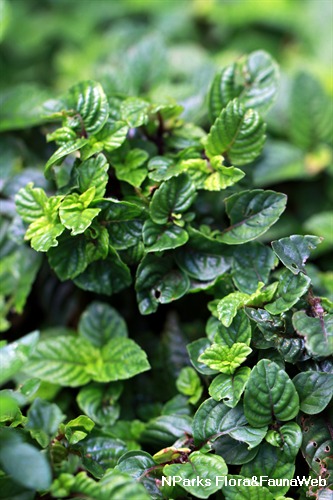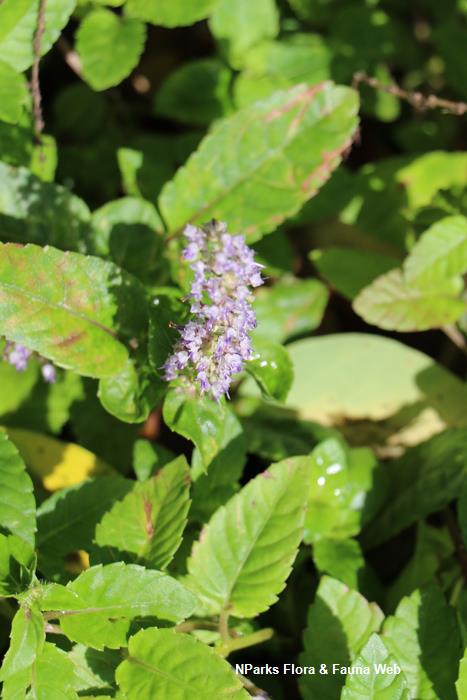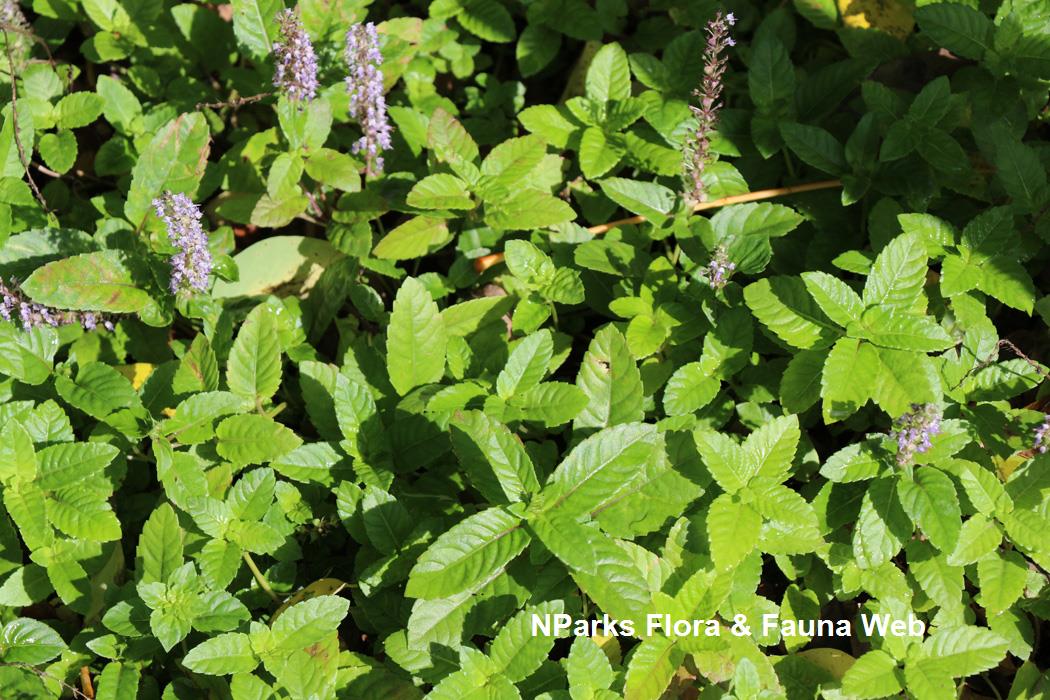
Back
Platostoma palustre (Blume) A.J.Paton
| Family Name: | Lamiaceae (Labiatae) |
| Synonyms: | Mesona procumbens Hemsl., Mesona chinensis Benth. |
| Common Name: | Chin Chow, Cincau, Hsian-tsao, 仙草, 涼粉草 |
Name
Classifications and Characteristics
| Plant Division | Angiosperms (Flowering Seed Plants) (Dicotyledon) |
|---|---|
| Plant Growth Form | Herbaceous Plant |
| Lifespan (in Singapore) | Perennial |
| Mode of Nutrition | Autotrophic |
| Maximum Height | 15 cm to 100 cm |
Biogeography
| Native Distribution | India, Myanmar, Indochina |
|---|---|
| Native Habitat | Terrestrial |
| Preferred Climate Zone | Tropical |
Description and Ethnobotany
| Growth Form | Perennial herb with trailing stems that are 15-100 cm long. |
|---|---|
| Foliage | Leaves are narrowly ovate (egg-shaped) to almost circular (2-5 cm long, 0.8-2.8 cm wide). |
| Stems | The stems may be hairless, pilose (covered in soft hairs) or finely bristly (covered in short, stiff hairs). |
| Flowers | White, reddish or light blue to purplish flowers (3 mm long) are arranged in verticillasters (a whorl-like inflorescence where flowers appear to surround the stem). The verticillasters are arranged in branched clusters known as panicles. The panicles are either erect or pointed upwards at an oblique angle. |
| Fruit | Black, elongated fruits are known as nutlets. |
| Cultivation | Chin Chow requires moist, but well-drained soil, and it is sensitive to drought. |
| Ethnobotanical Uses | Food (Herb or Spice): Leaves has been used to make jelly desserts and beverages by the Chinese for centuries. In Singapore, the dried leaves and shoots are sold in Chinese medical halls. Grass Jelly, a popular local dessert, is prepared by boiling the dried shoots in water with sugar and agar and allowing the strained liquid to set. Grass Jelly or Cincau Tea is thought to have a cooling effect on the body. Medicinal: Scientific Evidence of Medicinal Properties In pre-clinical trials, Chin Chow showed anti-inflammation (Dewanti et al., 2018), antioxidant (Yen et al., 2004) and cholesterol-lowering properties (Handayani et al., 2017) in animals. Traditional Medicinal Uses Research supports the Chinese traditional use of Chin Chow to treat joint pain. Other Chinese traditional uses include treating liver disease, hypertension and diabetes. It is important to note that some therapeutic effects from traditional medicinal uses of plants are not currently supported or verified by scientific research.
|
Landscaping Features
| Desirable Plant Features | Ornamental Flowers |
|---|---|
| Landscape Uses | Groundcover |
Plant Care and Propagation
| Light Preference | Full Sun, Semi-Shade |
|---|---|
| Water Preference | Moderate Water |
| Rootzone Tolerance | Moist Soils |
| Propagation Method | Seed, Stem Cutting (Tip, Herbaceous) |
Foliar
| Foliage Retention | Evergreen |
|---|---|
| Mature Foliage Colour(s) | Green |
| Mature Foliage Texture(s) | Smooth, Velvety / Furry / Tomentose, Spiny / Bristly / Stinging |
| Foliar Type | Simple / Unifoliate |
| Foliar Arrangement Along Stem | Opposite |
| Foliar Attachment to Stem | Petiolate |
| Foliar Shape(s) | Non-Palm Foliage (Ovate, Orbicular / Round) |
| Foliar Venation | Pinnate / Net |
| Foliar Margin | Serrate / Toothed |
| Foliar Apex - Tip | Acute, Obtuse |
| Foliar Base | Cuneate, Rounded / Obtuse |
Floral (Angiosperm)
| Flower Colour(s) | Purple, Red, White |
|---|---|
| Flower Grouping | Cluster / Inflorescence |
| Flower Location | Terminal |
| Individual Flower Shape | Labiate / Lipped |
| Inflorescence Type | Panicle |
| Inflorescence Type Remarks | Verticillasters arranged in panicles. |
| Flower Size | 3 mm |
Image Repository
Others
| Master ID | 30545 |
|---|---|
| Species ID | 4854 |
| Flora Disclaimer | The information in this website has been compiled from reliable sources, such as reference works on medicinal plants. It is not a substitute for medical advice or treatment and NParks does not purport to provide any medical advice. Readers should always consult his/her physician before using or consuming a plant for medicinal purposes. |








